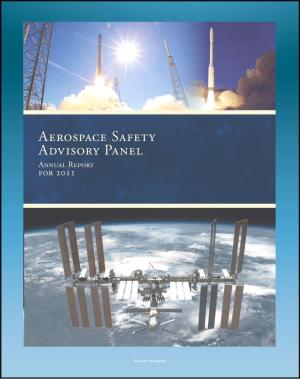2012 NASA Human Exploration Programs and Plans: Destinations (Moon, Near-Earth Asteroids, Lagrange Points, Mars), Goals, International Collaboration, Science, Path from LEO to Mars, Obama Speech
Nonfiction, Science & Nature, Technology, Aeronautics & Astronautics, Science, Physics, Astrophysics & Space Science| Author: | Progressive Management | ISBN: | 9781301608461 |
| Publisher: | Progressive Management | Publication: | October 8, 2012 |
| Imprint: | Smashwords Edition | Language: | English |
| Author: | Progressive Management |
| ISBN: | 9781301608461 |
| Publisher: | Progressive Management |
| Publication: | October 8, 2012 |
| Imprint: | Smashwords Edition |
| Language: | English |
NASA's latest human exploration plans and programs, endorsed by President Obama, are detailed in the seven documents reproduced in this unique compilation. The space agency states:
NASA is executing a bold plan of exploration and scientific discovery that will address key questions about our planet and the universe beyond; develop U.S. technical capabilities to send both robotic and crewed spacecraft on deep-space missions of exploration; enhance and maintain U.S. leadership in space, while continuing the Agency's tradition of collaboration with international partners; and inspire the next generation to pursue careers in the STEM fields. NASA will open up the space frontier, and bring back knowledge and experience that will shape our future endeavors.
Specifically, major science-based exploration goals include:
• Searching for signs of life (past or present);
• Understanding the structure, origin and evolution of the universe and of our solar system; and,
• Understanding the future of our planet.
NASA's human spaceflight program also serves broader national goals in strengthening U.S leadership and international collaboration, in technology development, and in education. Capability in human spaceflight is a great symbol of national prestige and leadership, and is a means through which the United States can cooperate and lead in the international arena.
As we develop the capabilities to send out human explorers, key early steps include:
• Robotic missions to conduct preliminary science, scout out possible destinations, and prepare for human exploration;
• Use of the ISS to develop the scientific, technological, and operational skills we will need for long-duration exploration missions; and,
• Human training and technology demonstration missions beyond Earth orbit.
The capabilities we are developing will open a broad range of exciting destinations for human exploration in the solar system. NASA's methodical approach to expanding the human presence into the solar system includes sending humans to an asteroid in the next decade and meeting the President's challenge of sending humans to Mars in the mid 2030s, when the orbital conditions will be most favorable. As capabilities grow, we will eventually be able to send humans to Mars. Mars is the planet most similar to Earth, and the one on which permanent extension of human civilization, aided by significant in-situ resources, is most feasible. The exploration of Mars has the potential to address a broad range of the most important questions in planetary science.
Chapter 1: NASA Exploration Destinations, Goals, and International Collaboration * Chapter 2: Voyages: Charting the Course for Sustainable Human Space Exploration * Chapter 3: Mars Program Planning Group September 2012 Report * Chapter 4 - Strategic Knowledge Gaps: Planning for Safe, Effective, and Efficient Human Exploration of the Solar System * Chapter 5 - Analysis of Strategic Knowledge Gaps Associated with Potential Human Missions to the Martian System * Chapter 6 - Senate and House Hearings on Exploration Goals, SLS, and Orion * Chapter 7: President Barack Obama on Space Exploration in the 21st Century
NASA's latest human exploration plans and programs, endorsed by President Obama, are detailed in the seven documents reproduced in this unique compilation. The space agency states:
NASA is executing a bold plan of exploration and scientific discovery that will address key questions about our planet and the universe beyond; develop U.S. technical capabilities to send both robotic and crewed spacecraft on deep-space missions of exploration; enhance and maintain U.S. leadership in space, while continuing the Agency's tradition of collaboration with international partners; and inspire the next generation to pursue careers in the STEM fields. NASA will open up the space frontier, and bring back knowledge and experience that will shape our future endeavors.
Specifically, major science-based exploration goals include:
• Searching for signs of life (past or present);
• Understanding the structure, origin and evolution of the universe and of our solar system; and,
• Understanding the future of our planet.
NASA's human spaceflight program also serves broader national goals in strengthening U.S leadership and international collaboration, in technology development, and in education. Capability in human spaceflight is a great symbol of national prestige and leadership, and is a means through which the United States can cooperate and lead in the international arena.
As we develop the capabilities to send out human explorers, key early steps include:
• Robotic missions to conduct preliminary science, scout out possible destinations, and prepare for human exploration;
• Use of the ISS to develop the scientific, technological, and operational skills we will need for long-duration exploration missions; and,
• Human training and technology demonstration missions beyond Earth orbit.
The capabilities we are developing will open a broad range of exciting destinations for human exploration in the solar system. NASA's methodical approach to expanding the human presence into the solar system includes sending humans to an asteroid in the next decade and meeting the President's challenge of sending humans to Mars in the mid 2030s, when the orbital conditions will be most favorable. As capabilities grow, we will eventually be able to send humans to Mars. Mars is the planet most similar to Earth, and the one on which permanent extension of human civilization, aided by significant in-situ resources, is most feasible. The exploration of Mars has the potential to address a broad range of the most important questions in planetary science.
Chapter 1: NASA Exploration Destinations, Goals, and International Collaboration * Chapter 2: Voyages: Charting the Course for Sustainable Human Space Exploration * Chapter 3: Mars Program Planning Group September 2012 Report * Chapter 4 - Strategic Knowledge Gaps: Planning for Safe, Effective, and Efficient Human Exploration of the Solar System * Chapter 5 - Analysis of Strategic Knowledge Gaps Associated with Potential Human Missions to the Martian System * Chapter 6 - Senate and House Hearings on Exploration Goals, SLS, and Orion * Chapter 7: President Barack Obama on Space Exploration in the 21st Century















